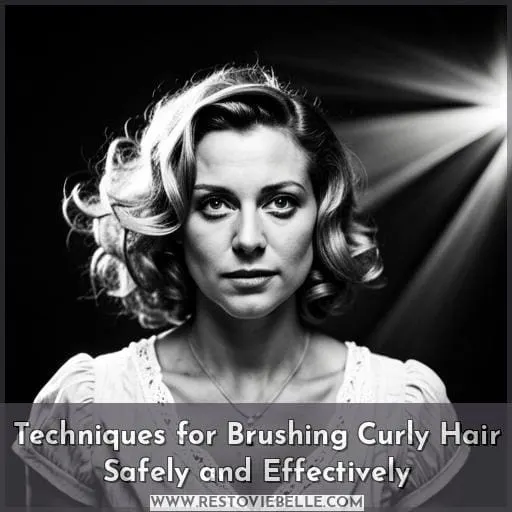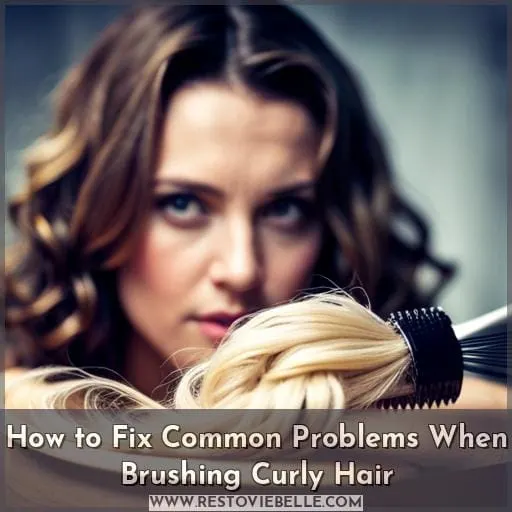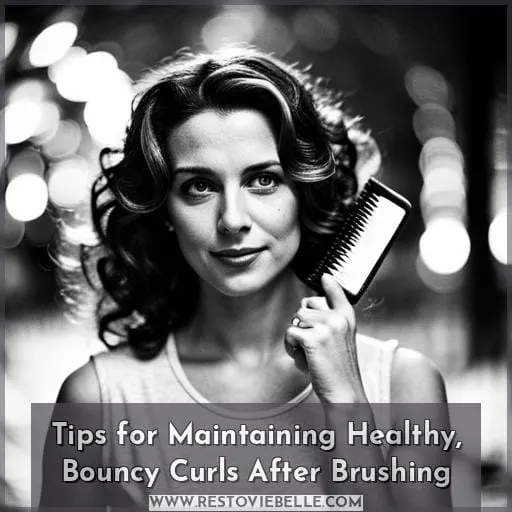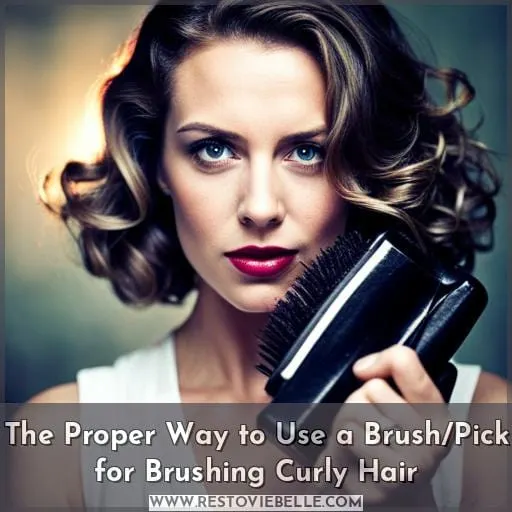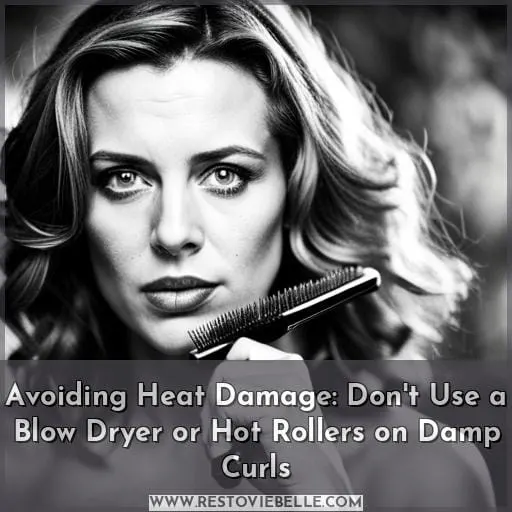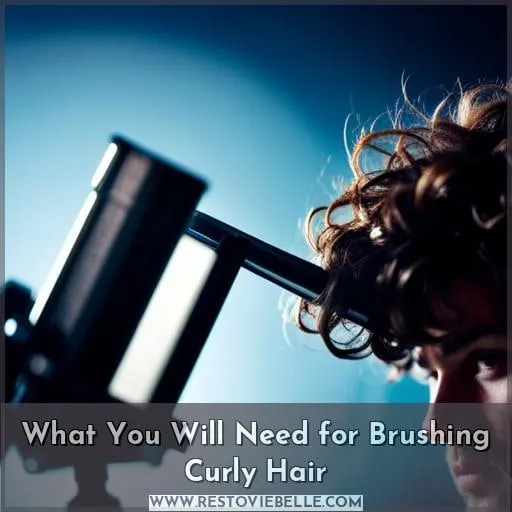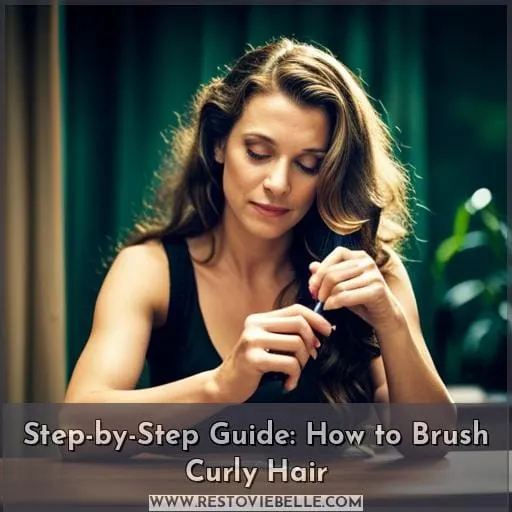This site is supported by our readers. We may earn a commission, at no cost to you, if you purchase through links.
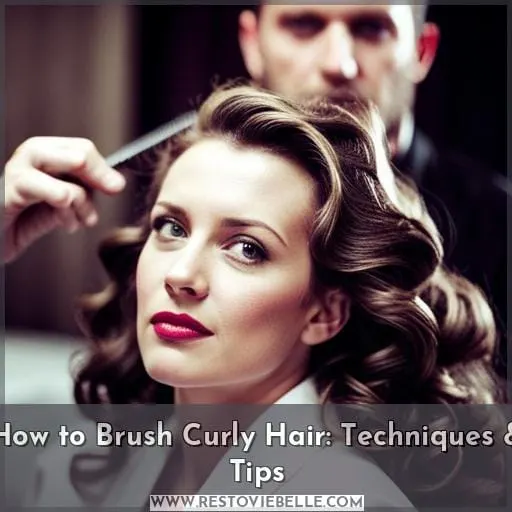 Are you struggling to brush your curly hair without causing frizz or tangles? Don’t worry, we’ve got you covered. In this article, we will share techniques and tips on how to brush curly hair safely and effectively.
Are you struggling to brush your curly hair without causing frizz or tangles? Don’t worry, we’ve got you covered. In this article, we will share techniques and tips on how to brush curly hair safely and effectively.
From choosing the right tools to maintaining healthy curls after brushing, we’ll guide you step-by-step through the process.
Let’s dive in and unlock the secrets of brushing curly hair.
Table Of Contents
- Key Takeaways
- Techniques for Brushing Curly Hair Safely and Effectively
- How to Fix Common Problems When Brushing Curly Hair
- Tips for Maintaining Healthy, Bouncy Curls After Brushing
- The Proper Way to Use a Brush/Pick for Brushing Curly Hair
- Avoiding Heat Damage: Don’t Use a Blow Dryer or Hot Rollers on Damp Curls
- What You Will Need for Brushing Curly Hair
- Step-by-Step Guide: How to Brush Curly Hair
- Frequently Asked Questions (FAQs)
- Conclusion
Key Takeaways
- Use a wide-tooth comb or your fingers.
- Start at the bottom of your hair and work your way up.
- Apply leave-in conditioner before brushing.
- Avoid using heat when brushing.
Techniques for Brushing Curly Hair Safely and Effectively
To safely and effectively brush your curly hair, start by using a wide-tooth comb or your fingers.
Don’t brush dry hair as it can cause damage and tangles.
Begin at the bottom of your hair and work your way up to avoid pulling on knots.
Before brushing, apply a leave-in conditioner to help detangle and protect your curls from damage.
Avoid using heat when brushing as it can lead to frizz and breakage.
Instead, let your hair air dry after brushing or use a diffuser on low heat if necessary.
By following these techniques for safe and effective brushing, you can maintain healthy curls without causing any unnecessary damage or discomfort in the process.
How to Fix Common Problems When Brushing Curly Hair
If your curls are tangling easily, use curl cremes to help smooth them out while brushing.
Here are some tips for fixing common problems when brushing curly hair:
- Use a wide-tooth comb:
Instead of using a brush, opt for a wide-tooth comb which is much gentler on curly hair and helps prevent tangles.
- Apply leave-in conditioner:
Before brushing, apply a leave-in conditioner or curl cream to add moisture and reduce friction between the strands.
- Start at the bottom:
Begin by gently detangling from the ends of your hair and work your way up towards the roots. This prevents further tangling and minimizes breakage.
Remember not to brush too much or apply excessive pressure as this can lead to damage.
Tips for Maintaining Healthy, Bouncy Curls After Brushing
To maintain healthy, bouncy curls after brushing your curly hair, remember to follow these essential tips:
- Use a leave-in conditioner:
- Avoid heat styling:
- Don’t brush too often:
- Start with wet hair:
- Detangle first:
By following these tips, you’ll be able to maintain healthy and bouncy curls even after brushing.
The Proper Way to Use a Brush/Pick for Brushing Curly Hair
To properly brush curly hair, start by detangling the strands using a wide-tooth comb or your fingers.
- Begin at the ends of the hair and work your way up to prevent unnecessary breakage.
- When brushing, go against the natural curl pattern gently and avoid pulling on knots or tangles.
- After brushing, allow your curls to air dry for best results in maintaining their shape and minimizing frizz.
Step 1—Detangling the Curly Strands
Start by gently detangling your curly strands using a wide-tooth comb or a bamboo hair pick.
This is an essential step in brushing curly hair as it helps to prevent breakage and minimize frizz.
When detangling, start at the bottom of your hair and work your way up, using gentle strokes to remove any knots or tangles.
Be patient and take your time with this process to ensure that you don’t cause any damage or unnecessary pulling on the curls.
Remember to avoid using heat during this step as it can further damage the hair strands.
Step 2—Starting at the Ends and Working Your Way Up
Now that you have detangled the curly strands, it’s time to start brushing or picking your hair from the ends and work your way up towards the roots.
Use a wide-tooth comb or gently use your fingers to avoid using too much force.
Be patient as you work through any tangles or knots, taking care not to cause breakage.
Remember to get regular trims to keep your hair healthy and prevent split ends.
Step 3—Brushing Against the Natural Curl Pattern
Begin by brushing against the natural curl pattern using a brush or pick to detangle your curly hair effectively.
To do this, follow these steps:
- Use a wide-tooth comb or pick: These tools are gentle on your curls and help prevent breakage.
- Start at the bottom: Begin brushing from the ends of your hair and work your way up to avoid tugging or pulling on knots.
Step 4—Air Drying After Brushing
To properly dry your curly hair after brushing, gently squeeze out any excess water using a microfiber towel or an old t-shirt.
Avoid rubbing the hair vigorously as this can cause frizz and damage. Instead, use a patting motion to absorb the moisture.
Once most of the water is removed, allow your curls to air dry naturally for best results.
Avoiding Heat Damage: Don’t Use a Blow Dryer or Hot Rollers on Damp Curls
Avoiding heat damage is crucial when it comes to brushing curly hair, so don’t use a blow dryer or hot rollers on damp curls.
Instead of using these tools, follow these tips to protect your curls:
- Use a wide-tooth comb: This type of comb helps detangle your curls without causing damage or disrupting the natural curl pattern.
- Avoid heat styling tools: Excessive heat can strip moisture from your hair and lead to further damage. It’s best to air dry or use a diffuser attachment on low heat settings instead.
- Use leave-in conditioner: Applying leave-in conditioner before brushing helps provide extra moisture and protection for your curls.
By following these guidelines and incorporating regular trims into your routine, you’ll keep your curly hair healthy while avoiding unnecessary heat damage.
What You Will Need for Brushing Curly Hair
To properly brush your curly hair, you’ll need a few essential tools and products.
First, a wide-tooth comb is crucial for detangling without causing damage or breakage. The wide gaps between the teeth of the comb prevent it from catching on your curls and causing frizz.
Additionally, using a leave-in conditioner or detangling spray can help to soften and moisturize your curls, making them easier to brush through.
Another useful tool for detangling curly hair is a bamboo pick, which gently separates knots and tangles without pulling on the strands.
When brushing your curly hair, remember to use gentle strokes to avoid damaging or disrupting the natural curl pattern.
Patience is key when it comes to detangling curly hair; take your time and be careful not to rush through this process.
Step-by-Step Guide: How to Brush Curly Hair
Now that you have all the necessary tools and products for brushing curly hair, let’s walk through the step-by-step process.
First, start by finger-detangling your hair with oil to minimize breakage.
Next, shampoo your hair to cleanse it thoroughly.
Then, section your hair into manageable parts before applying a moisturizing conditioner to each section.
Finally, rinse out the conditioner and gently brush through your curls using a wide-tooth comb or soft-bristled brush from bottom to top in small sections until all knots and tangles are gone.
Step 1—Finger-Detangle With Oil
Start by gently finger-detangling your curly hair with the help of some oil. This step is crucial to avoid tangles and minimize breakage.
Here’s how to do it:
- Start with wet hair
- Apply a small amount of leave-in conditioner or oil to your fingertips
- Section off your hair into manageable sections
- Working with one section at a time, use your fingers to gently detangle starting from the ends and working upwards towards the roots
- Repeat this process for each section until all tangles are removed
Step 2—Shampoo Your Hair
After finger-detangling with oil, it’s time to shampoo your curly hair.
Use warm water, not hot, and a gentle shampoo to cleanse your curls without stripping away natural oils.
Rinse thoroughly to ensure all product is removed from your hair.
After shampooing, condition your hair with a moisturizing conditioner to restore hydration and enhance curl definition.
Once you’ve rinsed out the conditioner, style your hair as desired for beautiful and healthy-looking curls.
Step 2—Shampoo Your Hair
- Use warm water
- Use a gentle shampoo
- Rinse thoroughly
- Condition
- Style
Step 3—Section Your Hair
Once you have shampooed your hair, it’s time to section your curly hair for easier brushing and detangling.
Sectioning helps you work through smaller portions of hair at a time, making the process more manageable.
To section your hair, start by parting it down the middle from forehead to nape and then divide each side into two or three sections depending on how much hair you have.
You can use clips or scrunchies to hold each section in place while you brush and detangle them separately.
Step 4—Apply Moisturizing Conditioner to Each Section
Apply moisturizing conditioner to each section of your hair before brushing, as this will help to hydrate and nourish your curls.
To properly apply the conditioner, follow these steps:
- Start with wet hair
- Use a wide-tooth comb to distribute the conditioner evenly
- Avoid applying too much product, as it can weigh down your curls
Remember that using a leave-in conditioner is also beneficial for preventing tangles and maintaining moisture throughout the day.
Step 5—Rinse Out the Conditione
To continue the process of brushing curly hair, you’ll need to rinse out the conditioner thoroughly.
Use a wide-tooth comb to gently brush through your hair, starting at the ends and working your way up. Be sure to use gentle strokes and avoid brushing too much, as this can cause breakage and frizz. Conditioning your hair is essential for maintaining its health and moisture levels.
| Step 5: Rinse Out the Conditioner |
|---|
| – Wet your curls completely |
| – Apply water |
| – Massage scalp |
Frequently Asked Questions (FAQs)
Can I brush my curly hair when it’s dry?
When brushing curly hair, it isn’t recommended to do so when it’s dry.
Dry brushing can lead to breakage and frizz.
It’s best to brush curly hair when it’s wet or damp for easier detangling and minimal damage.
What kind of brush should I use for my curly hair?
To brush your curly hair, use:
- A wide-tooth comb
- A soft-bristled brush designed for curly hair
These brushes are gentle and won’t cause breakage or frizz.
Avoid brushes with closely spaced bristles that can damage your curls.
Do I need to wash my hair brush?
To maintain cleanliness and prevent buildup, it is recommended to wash your hair brush regularly.
Use a gentle shampoo or soap to clean the bristles thoroughly, ensuring that all residue is removed for optimal brushing performance.
How often should I brush my curly hair?
To maintain the health and manageability of your curly hair, it’s recommended to brush it daily or as needed.
Regular brushing helps distribute natural oils, prevents tangling, and promotes a more defined curl pattern.
Can I use a pick instead of a brush to detangle my curly hair?
Yes, using a pick is an excellent alternative to brushing curly hair.
The wide teeth of the pick gently separate and detangle your curls without causing damage or frizz.
Conclusion
To achieve frizz-free and tangle-free curly hair, it’s essential to brush your curls safely and effectively.
By following the proper techniques and using the right tools, you can maintain healthy and bouncy curls.
[Keypoints]Remember to:
- Detangle gently.
- Start from the ends.
- Brush against the natural curl pattern.
- Avoid using heat and opt for air drying instead.
With these tips and a step-by-step guide, you can confidently brush your curly hair and enjoy beautiful, well-maintained curls.
